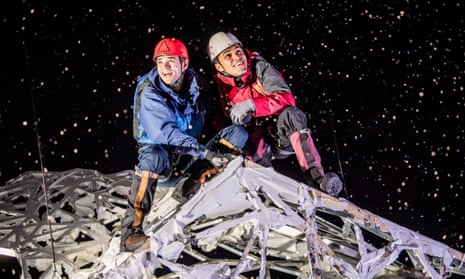When this adaptation of Joe Simpson’s mountaineering memoir, Touching the Void, opened at Bristol Old Vic in September last year, it was festooned with five-star reviews. Both David Greig’s script and Tom Morris’s production were praised to the skies for achieving the seemingly impossible: putting on stage the ascent by Simpson and Simon Yates of the west face of Siula Grande in the Peruvian Andes and the former’s heroic survival after being left for dead during the descent. Now the production has arrived at the Duke of York’s in London and faces the possibility of critical backlash. People will inevitably ask: was the initial enthusiasm justified?
Coming fresh to the story – neither having read Simpson’s memoir nor seen Kevin Macdonald’s 2003 film adaptation – I was fascinated by Morris’s skill in applying the techniques acquired from experimental theatre over the past 30 years to this mountaineering saga.
Morris was not only co-director of War Horse but for a decade ran Battersea Arts Centre, and here he makes brilliant use of everything he has learned. Simpson’s sister, Sarah (boldly played by Fiona Hampton), is taught the rudiments of climbing by ascending a cluster of tables and chairs that take her up to the theatre’s roof. The perilous journey toward Siula Grande is also evoked through the simplest means: silver trays represent glacial lakes, a pub toilet sign stands for a glacier, shaving-foam sprayed on a chair indicates snow and ice.
This is both a reminder of the injunction of the Chorus in Henry V to “let us … on your imaginary forces work” and proof that, in theatre, the most basic object can take on a symbolic power. For me, the production only loses momentum when it represents what actually happened on Siula Grande. Josh Williams and Angus Yellowlees, playing Simpson and Yates, are seen grappling with a monstrous papier-mache climbing-frame created by Ti Green. It is all very ingenious but the running commentary on the action provided by an observer at base camp is overlain by a pulsating sound-score. I couldn’t hear all the words and felt an already dramatic situation – the moral dilemma faced by Yates as to whether to cut the rope attaching him to Simpson rather than face mutual destruction – was being given a superfluous theatricality.
I needn’t have worried. The second half shows how Simpson – marooned in a crevasse and presumed dead – overcame exhaustion, hunger, thirst, frostbite and a broken leg to get back to base camp, and it is truly astonishing. A lot of theories have been advanced as to why this particular aspect of the story has seized the popular imagination: it has been suggested that it taps into our hunger for resurrection myths. I suspect it is mainly due to our respect for the capacity of the human will to triumph over adversity.
On stage, Simpson’s struggle is done very simply, with the actor inching his way precariously forward and his sister – this is Greig’s invention – becoming a mental and physical goad. The ultimate lesson of this production is that you can do anything in the theatre as long as you rely on the audience’s willing imagination.

Comments (…)
Sign in or create your Guardian account to join the discussion